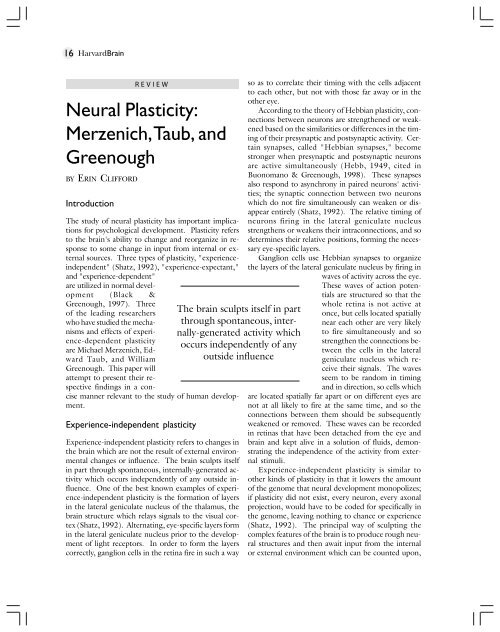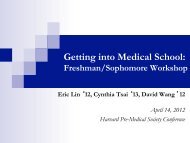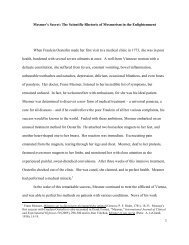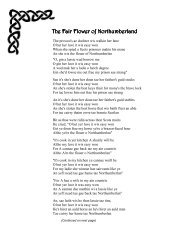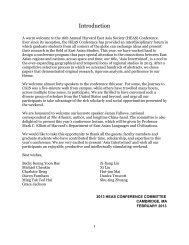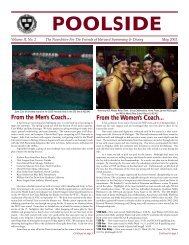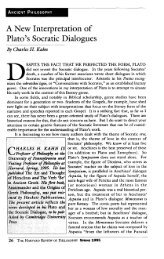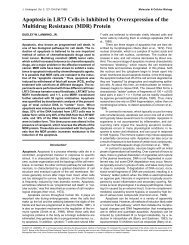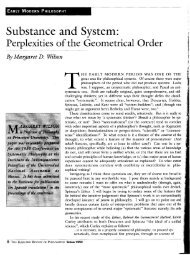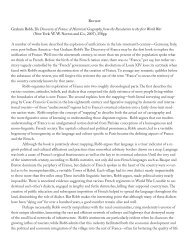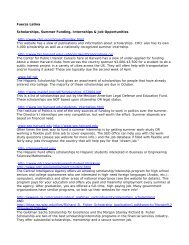Neural Plasticity: Merzenich,Taub, and Greenough
Neural Plasticity: Merzenich,Taub, and Greenough
Neural Plasticity: Merzenich,Taub, and Greenough
Create successful ePaper yourself
Turn your PDF publications into a flip-book with our unique Google optimized e-Paper software.
16<br />
HarvardBrain<br />
<strong>Neural</strong> <strong>Plasticity</strong>:<br />
<strong>Merzenich</strong>,<strong>Taub</strong>, <strong>and</strong><br />
<strong>Greenough</strong><br />
BY ERIN CLIFFORD<br />
Introduction<br />
REVIEW<br />
The study of neural plasticity has important implications<br />
for psychological development. <strong>Plasticity</strong> refers<br />
to the brain's ability to change <strong>and</strong> reorganize in response<br />
to some change in input from internal or external<br />
sources. Three types of plasticity, "experienceindependent"<br />
(Shatz, 1992), "experience-expectant,"<br />
<strong>and</strong> "experience-dependent"<br />
are utilized in normal development<br />
(Black &<br />
<strong>Greenough</strong>, 1997). Three<br />
of the leading researchers<br />
who have studied the mechanisms<br />
<strong>and</strong> effects of experience-dependent<br />
plasticity<br />
are Michael <strong>Merzenich</strong>, Edward<br />
<strong>Taub</strong>, <strong>and</strong> William<br />
<strong>Greenough</strong>. This paper will<br />
attempt to present their respective<br />
findings in a concise<br />
manner relevant to the study of human development.<br />
Experience-independent plasticity<br />
The brain sculpts itself in part<br />
through spontaneous, internally-generated<br />
activity which<br />
occurs independently of any<br />
outside influence<br />
Experience-independent plasticity refers to changes in<br />
the brain which are not the result of external environmental<br />
changes or influence. The brain sculpts itself<br />
in part through spontaneous, internally-generated activity<br />
which occurs independently of any outside influence.<br />
One of the best known examples of experience-independent<br />
plasticity is the formation of layers<br />
in the lateral geniculate nucleus of the thalamus, the<br />
brain structure which relays signals to the visual cortex<br />
(Shatz, 1992). Alternating, eye-specific layers form<br />
in the lateral geniculate nucleus prior to the development<br />
of light receptors. In order to form the layers<br />
correctly, ganglion cells in the retina fire in such a way<br />
so as to correlate their timing with the cells adjacent<br />
to each other, but not with those far away or in the<br />
other eye.<br />
According to the theory of Hebbian plasticity, connections<br />
between neurons are strengthened or weakened<br />
based on the similarities or differences in the timing<br />
of their presynaptic <strong>and</strong> postsynaptic activity. Certain<br />
synapses, called "Hebbian synapses," become<br />
stronger when presynaptic <strong>and</strong> postsynaptic neurons<br />
are active simultaneously (Hebb, 1949, cited in<br />
Buonomano & <strong>Greenough</strong>, 1998). These synapses<br />
also respond to asynchrony in paired neurons' activities;<br />
the synaptic connection between two neurons<br />
which do not fire simultaneously can weaken or disappear<br />
entirely (Shatz, 1992). The relative timing of<br />
neurons firing in the lateral geniculate nucleus<br />
strengthens or weakens their intraconnections, <strong>and</strong> so<br />
determines their relative positions, forming the necessary<br />
eye-specific layers.<br />
Ganglion cells use Hebbian synapses to organize<br />
the layers of the lateral geniculate nucleus by firing in<br />
waves of activity across the eye.<br />
These waves of action potentials<br />
are structured so that the<br />
whole retina is not active at<br />
once, but cells located spatially<br />
near each other are very likely<br />
to fire simultaneously <strong>and</strong> so<br />
strengthen the connections between<br />
the cells in the lateral<br />
geniculate nucleus which receive<br />
their signals. The waves<br />
seem to be r<strong>and</strong>om in timing<br />
<strong>and</strong> in direction, so cells which<br />
are located spatially far apart or on different eyes are<br />
not at all likely to fire at the same time, <strong>and</strong> so the<br />
connections between them should be subsequently<br />
weakened or removed. These waves can be recorded<br />
in retinas that have been detached from the eye <strong>and</strong><br />
brain <strong>and</strong> kept alive in a solution of fluids, demonstrating<br />
the independence of the activity from external<br />
stimuli.<br />
Experience-independent plasticity is similar to<br />
other kinds of plasticity in that it lowers the amount<br />
of the genome that neural development monopolizes;<br />
if plasticity did not exist, every neuron, every axonal<br />
projection, would have to be coded for specifically in<br />
the genome, leaving nothing to chance or experience<br />
(Shatz, 1992). The principal way of sculpting the<br />
complex features of the brain is to produce rough neural<br />
structures <strong>and</strong> then await input from the internal<br />
or external environment which can be counted upon,
in the organism's normal environment, to refine those<br />
structures in a way that is similar across individuals in<br />
a species. Many organisms, including humans, overproduce<br />
neurons <strong>and</strong> synapses <strong>and</strong> later cull those connections<br />
that are not used. By using the developing<br />
brain's capacity for plasticity, genes can code for r<strong>and</strong>omness<br />
in projections rather than specificity, <strong>and</strong> either<br />
cause self-generated internal activity (experienceindependent<br />
plasticity) or wait for external stimulation<br />
(experience-expectant plasticity) to precisely sculpt<br />
the needed connections.<br />
Experience-expectant plasticity<br />
Experience-expectant plasticity occurs when the brain<br />
uses input from the external environment to effect<br />
normal developmental changes in its structure. One<br />
example of experience-expectant sculpting is the formation<br />
of the ocular dominance columns in the visual<br />
cortex. The ocular dominance columns in an adult<br />
mammal are organized in alternating "stripes," each<br />
stripe receiving input from either the right or the left<br />
visual field. These columns are not fully developed<br />
when an infant is born; the visual cortex organizes<br />
itself according to the input it receives through the<br />
left <strong>and</strong> right visual fields. For example, if a cat is<br />
visually deprived from birth, its visual cortex does not<br />
develop neatly into the typical left-right striped pattern;<br />
instead, the axons projecting to the visual cortex<br />
from the separate fields can overlap with each other<br />
(Hubel & Wiesel, 1962).<br />
Similarly, in humans, childhood cataracts can cause<br />
permanent blindness if not treated properly, while the<br />
same cataracts in adults cause visual impairment only<br />
until they are removed through surgery (von Senden,<br />
1932). This suggests a sensitive period for the development<br />
of the visual cortex, during which the absence<br />
of the experiential input needed to refine the pattern<br />
of connections can cause damage much more severe<br />
than in an adult brain (Shatz, 1992).<br />
Experience-expectant plasticity is perhaps the simplest<br />
type of plasticity to manipulate. If the expected,<br />
normal input from the environment is not present or<br />
is blocked experimentally or accidentally in the course<br />
of development, the feature which needed that input<br />
to develop will mature abnormally or not at all. Learning<br />
more about experience-expectant plasticity in the<br />
developing brain might help researchers overcome the<br />
adverse effects of accidental deprivation of input in<br />
human fetuses, infants, <strong>and</strong> children. If researchers<br />
understood exactly how deprivation engenders abnormal<br />
brain development, they could perhaps use the<br />
HarvardBrain 17<br />
brain's plasticity to reverse the effects of deprivation<br />
or to provide the correct type of artificial input to<br />
replace the normal, expected experience necessary for<br />
development.<br />
Experience-dependent plasticity<br />
Experience-dependent plasticity occurs in features of<br />
the brain that may not need experience to develop but<br />
can be changed or modified by it. If a modification<br />
to the internal or external environment produces<br />
change in a feature of the brain, that feature is said to<br />
possess experience-dependent plasticity. Learning is a<br />
form of experience-dependent plasticity, inasmuch as<br />
it is reflected in changes in the learner's brain<br />
(<strong>Greenough</strong> & Black, 1997). The physical changes<br />
which take place during learning are most likely caused<br />
at the neuronal level by Hebbian plasticity, strengthening<br />
or weakening synapses depending on the relative<br />
timing of the neurons' activity (as explained above).<br />
If two stimuli always appear together, the neurons receiving<br />
input from those paired stimuli consistently<br />
fire together, <strong>and</strong> the connection between them is<br />
strengthened. Thus, a type of learning, an increase in<br />
the association of two temporally paired stimuli, occurs.<br />
These changes in neuronal connections could<br />
lead to changes in the topography of the overall cortical<br />
structure. In primates, connections in the visual,<br />
auditory, <strong>and</strong> somatosensory cortices can be influenced<br />
by experience, <strong>and</strong> some subcortical structures may<br />
also be shaped by some degree of experience-dependent<br />
plasticity (Pons et al., 1991).<br />
The existence of plasticity demonstrates that the<br />
development of the brain is not dictated solely by<br />
genes; the plasticity that the brain retains after birth<br />
ensures that each individual's brain is unique, even if<br />
two (or more) individuals have identical sets of genes.<br />
Experience-dependent plasticity allows the brain to<br />
respond flexibly to unanticipated changes in input (an<br />
important trait in a changing environment) <strong>and</strong> to<br />
allocate its limited area efficiently according to the<br />
input it receives from various sources. Michael<br />
<strong>Merzenich</strong>, Edward <strong>Taub</strong>, <strong>and</strong> William <strong>Greenough</strong> all<br />
deal primarily with experience-dependent plasticity.<br />
<strong>Merzenich</strong>: Experience affects cortical representations<br />
<strong>Merzenich</strong> demonstrated some of the effects of action<br />
on the adult primate brain. If a body part becomes<br />
less or more active, such as by deafferentation or by
18<br />
HarvardBrain<br />
repeated use in learning paradigms, its topographical<br />
representation in the somatosensory cortex shrinks or<br />
enlarges, respectively (Recanzone et al., 1992;<br />
<strong>Merzenich</strong> et al., 1983a,b; Buonomano & <strong>Merzenich</strong>,<br />
1998). Often, these changes cause proportional enlargement<br />
or shrinkage of adjacent cortical representational<br />
areas, apparently in order to utilize cortical<br />
space <strong>and</strong> neurons more efficiently.<br />
Two of <strong>Merzenich</strong>'s experiments demonstrating the<br />
effects of repeated action <strong>and</strong> attention or persistent<br />
inaction on the somatosensory cortex involved the fingers<br />
of owl monkeys, which are topographically represented<br />
in Area 3b of the somatosensory cortex. In<br />
one experiment, <strong>Merzenich</strong> measured the cortical representations<br />
of the h<strong>and</strong> in three groups of owl monkeys<br />
(Recanzone et al., 1992). One group was trained<br />
in a frequency discrimination task in which they learned<br />
to discriminate between increasingly similar frequencies<br />
of a fluttering stimulus applied to a consistent<br />
area of skin on one finger. Another group was passively<br />
stimulated, with no learning, <strong>and</strong> a third group<br />
was not stimulated at all. After several weeks of training,<br />
<strong>Merzenich</strong> <strong>and</strong> his colleagues inserted microelectrodes<br />
into the relevant sections of each monkey's somatosensory<br />
cortex to measure the neurons' activity<br />
during differential stimulation of areas of skin on the<br />
fingers.<br />
When they mapped the representations of the cutaneous<br />
inputs onto the somatosensory cortex for the<br />
three groups, they found no change in the cortical<br />
representations of the control group with who had<br />
experienced no prior stimulation, <strong>and</strong> only minimal<br />
enlargement of the cortical area representing the stimulated<br />
skin in the untrained, stimulated monkeys. In<br />
the trained monkeys, however, that cortical area was<br />
significantly (1.5 to >3 times) larger than in the controls.<br />
In addition to the original representational area,<br />
an additional 1-2 mm of cortex, which had previously<br />
received input from other parts of the h<strong>and</strong>, now received<br />
inputs from the trained section of skin. The<br />
increased use of a body part <strong>and</strong> attention to the input<br />
resulting from that use effectively altered the structure<br />
of the somatosensory cortex. Other experiments<br />
have been done replicating these results for the auditory<br />
cortex (Recanzone et al., 1993). <strong>Merzenich</strong>'s<br />
finding implies that use may help determine the proportional<br />
allotment of topographical representations<br />
in the somatosensory cortex.<br />
In a converse manipulation, <strong>Merzenich</strong> transected<br />
the median nerves of a group of monkeys, removing<br />
all of the normal input from the ventral portions of<br />
the thumb <strong>and</strong> the first two fingers to the somatosen-<br />
sory cortex (Areas 3b <strong>and</strong> 1) (<strong>Merzenich</strong> et al.,<br />
1983a,b, cited in Buonomano & <strong>Merzenich</strong>, 1998).<br />
Immediate changes in the cortical representations of<br />
these areas were apparent; adjacent cortical representations<br />
of other parts of the fingers <strong>and</strong> h<strong>and</strong> encroached<br />
on the area which had previously represented<br />
the deafferentated parts, <strong>and</strong> this reorganization continued<br />
<strong>and</strong> increased for several weeks. This finding<br />
reiterates the importance of continued use in maintaining<br />
normal topographical cortical representations.<br />
Experience-dependent plasticity confers a definite advantage<br />
on the organism by allowing parts of the brain<br />
which are initially abnormal or deficient to sometimes<br />
be corrected through experience.<br />
<strong>Taub</strong>: Unused cortical area is taken over by<br />
adjacent representations<br />
<strong>Taub</strong>, like <strong>Merzenich</strong>, studied the effects of use/disuse<br />
on the brain. <strong>Taub</strong> provided one of the most<br />
dramatic examples to date regarding the possible extent<br />
of encroachment by adjacent areas into an unused<br />
area of the somatosensory cortex. He studied<br />
monkeys 12 years after they had received<br />
deafferentations of one or both of their upper limbs<br />
(Pons et al., 1991). Prior to this experiment, the greatest<br />
cortical reorganization that had been demonstrated<br />
amounted to only about 1-2 mm of encroachment in<br />
the cortex, leaving substantial areas bereft of any responsive<br />
properties after amputation or deafferentation<br />
of their inputs. Surprisingly, <strong>Taub</strong>'s monkeys'<br />
somatosensory cortices were completely responsive.<br />
There were no areas which did not respond to stimulation;<br />
the entire area which had previously represented<br />
the upper limb(s) now responded to stimulation of<br />
other areas whose representations had been adjacent<br />
to the upper limbs' representations in the cortex. This<br />
amounted to an encroachment of 10-14 mm, demonstrating<br />
cortical representational plasticity of at least<br />
one order of magnitude greater than previously<br />
thought possible.<br />
<strong>Taub</strong>'s data disproved a previous theory (cited in<br />
Pons et al., 1991) regarding the mechanisms underlying<br />
cortical plasticity. The "unmasking" theory holds<br />
that plasticity is due to the arborization of single axons<br />
projecting from the thalamus to different representational<br />
areas of the cortex (see Ramach<strong>and</strong>ran et al.,<br />
1992). Under this theory, plasticity is caused by the<br />
transfer of input from the same axon into two cortical<br />
areas, the area to which it would normally go <strong>and</strong> another<br />
area, which normally inhibits this axon's input,
ut which now accepts it for lack of its normal input.<br />
The extent of arborization of the thalamocortical axons<br />
is about 1-2 mm, so that theory fit with previous data,<br />
but was disproved as a primary source of cortical plasticity<br />
by <strong>Taub</strong>'s data, which demonstrated plasticity<br />
of at least 10-14 mm, too great to be caused by arborization<br />
of single axons. <strong>Taub</strong> (Pons et al., 1991)<br />
suggests that much of the observed reorganization<br />
may be due to changes not in the cortex itself, but in<br />
subcortical structures, such as the brainstem <strong>and</strong> thalamus.<br />
He explains that small changes in the mapping<br />
of features in the brainstem translate into larger changes<br />
as the representations increase in size sequentially in<br />
the thalamus <strong>and</strong> cortex, so that arborization or axonal<br />
sprouting could indeed be culpable for plasticity,<br />
but not as directly as previously thought. Instead,<br />
<strong>Taub</strong> proposes a theory of an unnamed type of subcortical<br />
plasticity, which has yet to be directly documented,<br />
but which would yield plasticity in the overall<br />
brain much greater than previously thought possible.<br />
In any case, <strong>Taub</strong>'s data demonstrates that the<br />
brain has a great potential for change.<br />
William <strong>Greenough</strong>: Rich early environment<br />
creates neurons for learning<br />
<strong>Greenough</strong>'s work clearly shows that an organism's<br />
environment during infancy <strong>and</strong> childhood can influence<br />
brain structure.<br />
<strong>Greenough</strong> <strong>and</strong> his colleagues<br />
raised two groups of<br />
Experimenters might be<br />
encouraged to attempt further<br />
studies of human developmental<br />
environments <strong>and</strong> their<br />
impact on learning, using data<br />
from these experiments to<br />
help create a time frame for<br />
their studies.<br />
young, post-weaning rats,<br />
ages 28-32 days, in two very<br />
different environments<br />
(Comery et al., 1995, 1996).<br />
One group was put in individual<br />
cages <strong>and</strong> provided<br />
with only food <strong>and</strong> water,<br />
while the other group was<br />
put in cages together with<br />
other rats <strong>and</strong> a multitude of<br />
toys <strong>and</strong> interesting, changing<br />
stimuli to explore. When<br />
<strong>Greenough</strong> examined their<br />
brains thirty days later, he found an important discrepancy:<br />
The rats reared in the complex environment<br />
had 60% more multiple-headed dendritic spines<br />
on neurons of the striatum than the control rats. This<br />
neurological change is a type of experience-dependent<br />
neural plasticity, <strong>and</strong> the specific type of change, the<br />
appearance of more multiple-headed dendritic spines,<br />
HarvardBrain 19<br />
may create the potential for further neural plasticity in<br />
the form of learning.<br />
The finding of <strong>Greenough</strong> <strong>and</strong> his colleagues disproves<br />
the general assumption that any new synapses<br />
added as a result of experience are equivalent to previously<br />
extant synapses (Comery et al., 1996). Rats<br />
reared in a complex environment (EC) had a 30%<br />
higher density of multiple-headed spines than the controls,<br />
meaning that a given synapse in an EC rat's brain<br />
was more likely to be connected to a dendrite with<br />
more than one head. <strong>Greenough</strong> <strong>and</strong> his colleagues<br />
(Comery et al., 1996) refer to a recent theory which<br />
states that synaptic configurations involving multiple<br />
associated contacts may facilitate plastic change. Multiple-headed<br />
spines may indicate the presence of parallel<br />
connections between neurons. These connections<br />
could strengthen or weaken existing connections or<br />
could connect to a new synapse, altering the pattern<br />
of connections between the neurons. Such changes in<br />
the neural web of connections could aid learning, especially<br />
under the theory of Hebbian plasticity (Hebb,<br />
1949, cited in Buonomano & <strong>Merzenich</strong>, 1998). The<br />
strong connections between temporally associated synapses<br />
could form the neural basis for learning, <strong>and</strong><br />
multiple-headed spines could aid the brain in making<br />
<strong>and</strong> strengthening such connections.<br />
Synaptic contacts involving those spines seem more<br />
prevalent in rats who have had more opportunity for<br />
exploration of new stimuli <strong>and</strong> social contacts, those<br />
reared in the EC. It seems that<br />
rats exposed to a complex, interesting<br />
environment, which<br />
facilitates learning <strong>and</strong> multiple<br />
connections early in life,<br />
might gain an edge in learning<br />
later, due to their relative<br />
abundance of multiple-headed<br />
spines (although testing on<br />
the rats' actual ability to learn<br />
has yet to be done).<br />
Further testing with the<br />
two groups of adult rats might<br />
be able to determine whether<br />
the EC rats are truly better<br />
learners than the controls. If<br />
rats with more multiple-headed dendritic spines were<br />
able to learn tasks more easily than controls, it might<br />
be concluded that the rearing environment could affect<br />
the capacity for learning by providing the brain<br />
with the opportunity to create more parallel neural<br />
connections <strong>and</strong> strengthen existing ones by the principle<br />
of Hebbian plasticity. Developmental experiments
20<br />
HarvardBrain<br />
with new rats could discover if more time in, or earlier<br />
exposure to, the differentiated environments further<br />
increases the EC rats' number of multiple-headed dendritic<br />
spines or learning capacities in relation to the<br />
controls. If age at exposure was relevant, that data<br />
could suggest the existence of a sensitive period for<br />
the development of the neuronal changes described<br />
above. Experimenters might be encouraged to attempt<br />
further studies of human developmental environments<br />
<strong>and</strong> their impact on learning, using data<br />
from these experiments to help create a time frame for<br />
their studies.<br />
Conclusion<br />
<strong>Merzenich</strong> <strong>and</strong> <strong>Greenough</strong> have researched some effects<br />
of externally caused experience-dependent neural<br />
plasticity: <strong>Merzenich</strong> studied how the brain is altered<br />
in response to changes in the body, <strong>and</strong> <strong>Greenough</strong><br />
studied how the brain is altered in response to the<br />
external environment. <strong>Taub</strong> discovered some largerthan-expected<br />
changes in the brain's topography <strong>and</strong><br />
theorized about the underlying mechanisms of plasticity.<br />
These three researchers have made substantial<br />
additions to the body of literature concerning experience-dependent<br />
plasticity, <strong>and</strong> their findings may help<br />
others develop ways to use the brain's potential for<br />
change to help those people with neural deficits redesign<br />
their own minds.<br />
References<br />
Black, J.E. & <strong>Greenough</strong>, W.T. (1998) Developmental<br />
approaches to the memory process. In Martinez, J.L.<br />
Jr. & Kesner, R.P. (Eds.) Neurobiology of learning <strong>and</strong><br />
memory (pp. 55-88). San Diego, CA: Academic Press,<br />
Inc.<br />
Buonomano, D.V., & <strong>Merzenich</strong>, M.M. (1998) Cortical<br />
plasticity: from synapses to maps. Annual Review of Neuroscience<br />
21:149-186.<br />
Comery, T.A., Shah, R., & <strong>Greenough</strong>, W.T. (1995) Differential<br />
rearing alters spine density on medium-sized spiny<br />
neurons in the rat corpus striatum: Evidence for association<br />
of morphological plasticity with early response gene<br />
expression. Neurobiology of Learning <strong>and</strong> Memory<br />
63:217-219.<br />
Comery, T.A., Stamoudis, C.X., Irwin, S.A., &<br />
<strong>Greenough</strong>, W.T. (1996) Increased density of multiplehead<br />
dendritic spines on medium-sized neurons of the<br />
striatum in rats reared in a complex environment. Neurobiology<br />
of Learning <strong>and</strong> Memory 66(2):93-96<br />
Hebb, D. O. (1949) The Organization of Behavior: A<br />
Neuropsychological Theory. New York: Wiley.<br />
Hubel, D.H. & Wiesel, T.N. (1962) Receptive fields, binocular<br />
interaction, <strong>and</strong> functional architecture in the cat's<br />
visual cortex. Journal of Physiology 160:106-154.<br />
<strong>Merzenich</strong>, M.M., Kaas, J.H., Wall, J., Nelson, R.J., Sur,<br />
M., & Felleman, D. (1983a) Topographic reorganization<br />
of somatosensory cortical areas 3b <strong>and</strong> 1 in adult<br />
monkeys following restricted deafferentation. Neuroscience<br />
8:33-55.<br />
<strong>Merzenich</strong>, M.M., Kaas, J.H., Wall, J., Sur, M., Nelson,<br />
R. J., & Felleman, D. (1983b) Progression of changes<br />
following median nerve section in the cortical representation<br />
of the h<strong>and</strong> in areas 3b <strong>and</strong> 1 in adult owl <strong>and</strong><br />
squirrel monkeys. Neuroscience 10:639-665.<br />
Pons, T.P., Garraghty, P.E., Ommaya, A.K., Kaas, J.H.,<br />
<strong>Taub</strong>, E., & Mishkin, M. (1991). Massive cortical reorganization<br />
after sensory deafferentation in adult<br />
macaques. Science 252(5014):1857-1860.<br />
Ramach<strong>and</strong>ran, V.S., Rogers-Ramach<strong>and</strong>ran, D., Stewart,<br />
M. (1992) Perceptual correlates of massive cortical reorganization.<br />
Science 258:1159-1160.<br />
Rauschecker, J.P. (1995) Compensatory plasticity <strong>and</strong> sensory<br />
substitution in the cerebral cortex. Trends in Neuroscience<br />
18:36-43.<br />
Recanzone, G.H., <strong>Merzenich</strong>, M.M., Jenkins, W.M.,<br />
Grajski, K.A., & Dinse, H.R. (1992) Topographic reorganization<br />
of the h<strong>and</strong> representation in cortical area 3b<br />
of owl monkeys trained in a frequency-discrimination<br />
task. Journal of Neurophysiology 67:1031-1056.<br />
Recanzone, G.H., Schreiner, C.E., & <strong>Merzenich</strong>, M. M.<br />
(1993) <strong>Plasticity</strong> in the frequency representation of primary<br />
auditory cortex following discrimination training in<br />
adult owl monkeys. Journal of Neuroscience 13(1):87-<br />
103.<br />
Shatz, C.J. (1992) The developing brain. Scientific American<br />
267(3):60-67.<br />
von Senden, M. (1932) Space <strong>and</strong> Sight. P. Heath (trans.)<br />
Glencoe, Ill.: Free Press, 1960.


